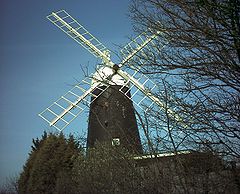Stretham
| Stretham | |
|---|---|
 Stretham Windmill |
|
| Stretham shown within Cambridgeshire | |
| Area | 6.27 sq mi (16.2 km2) |
| Population | 1,831 |
| • Density | 292/sq mi (113/km2) |
| OS grid reference | TL513747 |
| • London | 64 mi (103 km) S |
| Civil parish |
|
| District | |
| Shire county | |
| Region | |
| Country | England |
| Sovereign state | United Kingdom |
| Post town | ELY |
| Postcode district | CB6 |
| Dialling code | 01353 |
| Police | Cambridgeshire |
| Fire | Cambridgeshire |
| Ambulance | East of England |
| EU Parliament | East of England |
| UK Parliament | |
| Website | www |
Stretham /ˈstrɛtəm/ is a village and civil parish 4 miles (6 km) south-south-west of Ely in Cambridgeshire, England, about 74 miles (119 km) by road from London. Its main attraction is Stretham Old Engine, a steam-powered pump used to drain the fens. The pump is still in use today although converted to electric power. It has open days throughout the year.
A Bronze Age hoard consisting of gold jewellery including a torque, bracelet, six ribbed-rings as well as a bronze rapier was discovered in Granta Fen near Stretham in 1850. Dating to between 1300 and 1000 BC, the torque is in the Hunt Museum in Limerick while the remainder of the treasure is in the British Museum.
Stretham means homestead or village on the road (possibly Roman); Latin strata for paved road or old English ystrad for road plus old English ham for village. The route of the Roman road from Cambridge is uncertain beyond Waterbeach.
Brythnoth (the first Abbot of the Benedictine monastery at Ely Abbey) and Æthelwold (Bishop of Winchester) purchased the Stretham estate, among others including Haddenham, Wilburton and Witchford, after the restoration of the monastery in 970 with the encouragement of King Edgar. The Domesday Book records the village as ′Stradham: Abbot of Ely. Fisheries.′
...
Wikipedia

